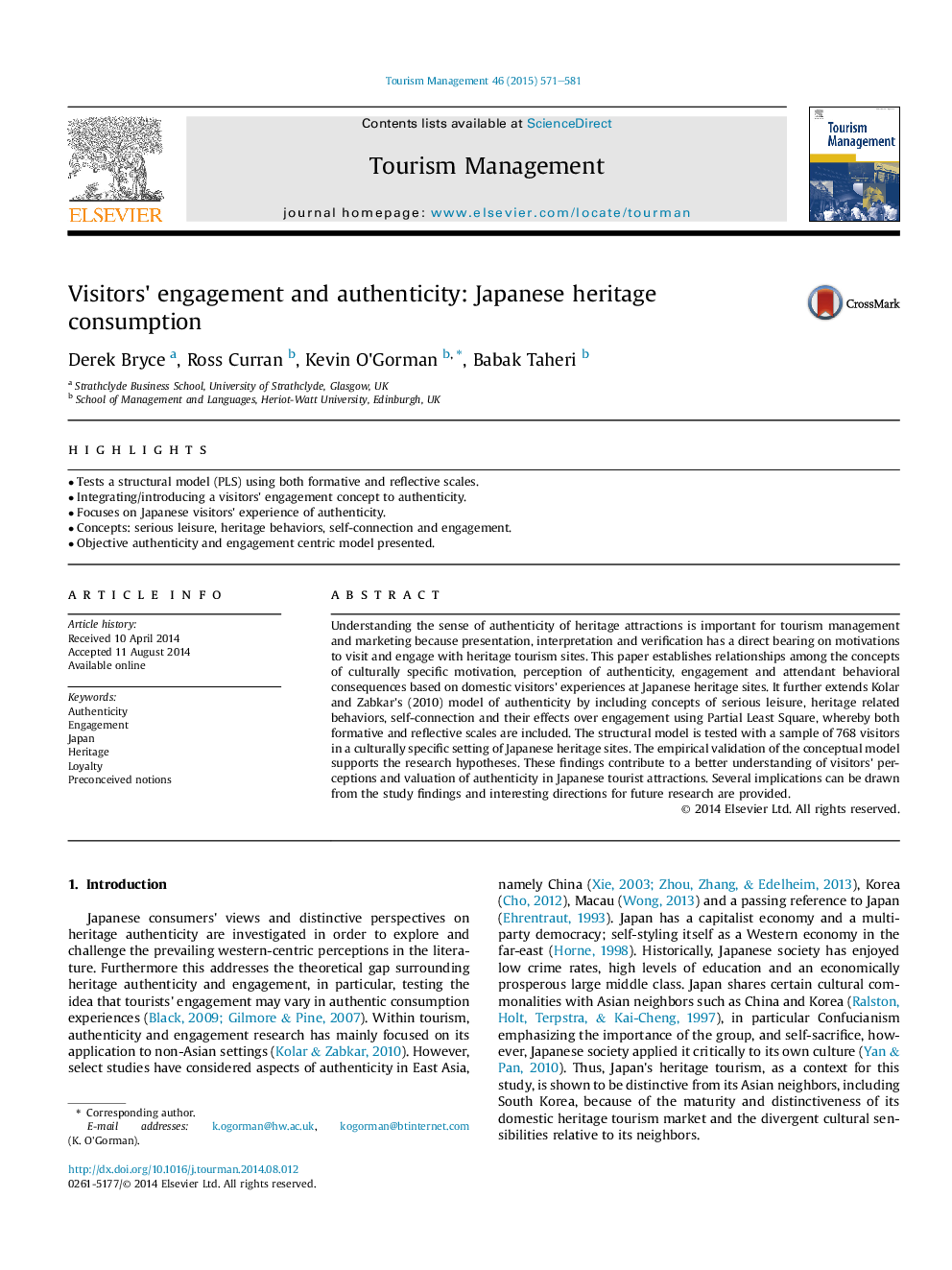| کد مقاله | کد نشریه | سال انتشار | مقاله انگلیسی | نسخه تمام متن |
|---|---|---|---|---|
| 7422295 | 1482637 | 2015 | 11 صفحه PDF | دانلود رایگان |
عنوان انگلیسی مقاله ISI
Visitors' engagement and authenticity: Japanese heritage consumption
ترجمه فارسی عنوان
مشارکت و اعتبار بازدید کنندگان: مصرف میراث ژاپن
دانلود مقاله + سفارش ترجمه
دانلود مقاله ISI انگلیسی
رایگان برای ایرانیان
کلمات کلیدی
اعتبار، نامزدی، ژاپن، میراث، وفاداری، مفاهیم پیش بینی شده،
ترجمه چکیده
شناخت صحیح جاذبه های میراث برای مدیریت گردشگری و بازاریابی مهم است زیرا ارائه، تفسیر و تأیید مستلزم تأثیر مستقیم بر انگیزه های بازدید و مشارکت با سایت های گردشگری میراث است. این مقاله روابطی را در میان مفاهیم انگیزشی فرهنگی خاص، درک صحیح، تعامل و پیامدهای رفتاری همراه بر مبنای تجربیات بازدید کنندگان داخلی در سایت های میراث ژاپن برقرار می کند. این مدل مدل اصیل بودن کالار و زبکار (2010) را با استفاده از مفاهیم اوقات فراغت جدی، رفتارهای مرتبط با میراث، ارتباط خود و اثرات آن بر تعامل با استفاده از میدان کمترین جزئی، گسترش می دهد که در آن مقیاس های تشکیل دهنده و بازتابنده نیز گنجانده شده است. مدل ساختاری با نمونه ای از 768 بازدید کننده در یک محیط فرهنگی خاص از سایت های میراث ژاپنی آزمایش شده است. اعتبار تجربی مدل مفهومی از فرضیه های تحقیق پشتیبانی می کند. این یافته ها به درک بهتر دیدگاه بازدید کنندگان و ارزیابی اعتبار در جاذبه های گردشگری ژاپن کمک می کند. از نتایج یافته ها و جهات جالب برای تحقیقات آینده ارائه شده است.
موضوعات مرتبط
علوم انسانی و اجتماعی
مدیریت، کسب و کار و حسابداری
استراتژی و مدیریت استراتژیک
چکیده انگلیسی
Understanding the sense of authenticity of heritage attractions is important for tourism management and marketing because presentation, interpretation and verification has a direct bearing on motivations to visit and engage with heritage tourism sites. This paper establishes relationships among the concepts of culturally specific motivation, perception of authenticity, engagement and attendant behavioral consequences based on domestic visitors' experiences at Japanese heritage sites. It further extends Kolar and Zabkar's (2010) model of authenticity by including concepts of serious leisure, heritage related behaviors, self-connection and their effects over engagement using Partial Least Square, whereby both formative and reflective scales are included. The structural model is tested with a sample of 768 visitors in a culturally specific setting of Japanese heritage sites. The empirical validation of the conceptual model supports the research hypotheses. These findings contribute to a better understanding of visitors' perceptions and valuation of authenticity in Japanese tourist attractions. Several implications can be drawn from the study findings and interesting directions for future research are provided.
ناشر
Database: Elsevier - ScienceDirect (ساینس دایرکت)
Journal: Tourism Management - Volume 46, February 2015, Pages 571-581
Journal: Tourism Management - Volume 46, February 2015, Pages 571-581
نویسندگان
Derek Bryce, Ross Curran, Kevin O'Gorman, Babak Taheri,
